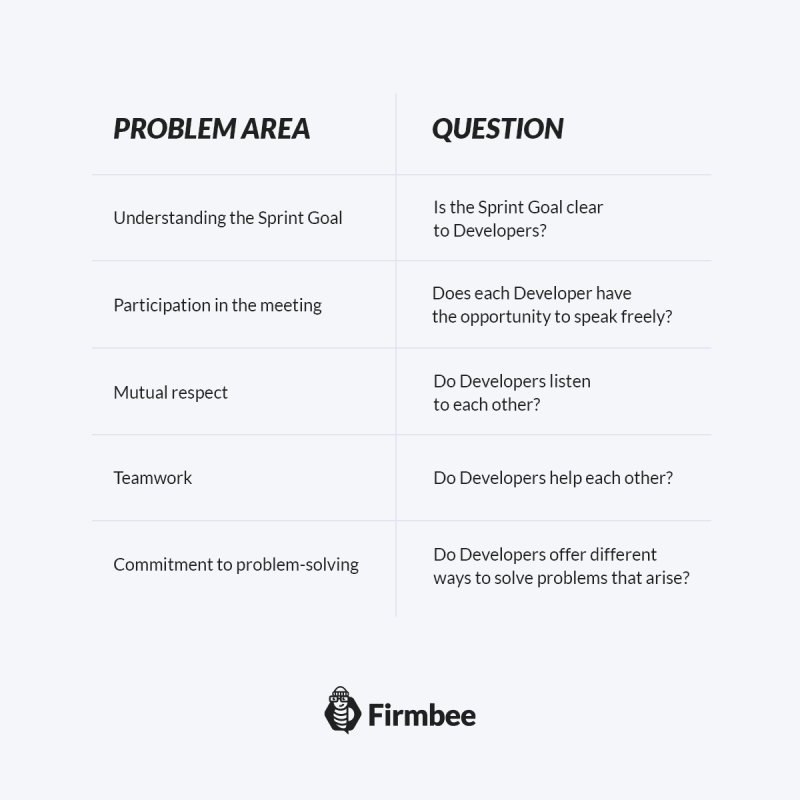The Daily Scrum lasts no more than fifteen minutes and is always held in the same place and at the same time to reduce unnecessary complexity. It is attended by all Developers working together on the Product and, optionally, the Scrum Master. The main purpose of this Scrum Event is to plan the tasks they will focus on for the day.
Daily Scrum – table of contents:
- Introduction
- The Daily Scrum formula
- Problems with Daily Scrum and the 5W method
- Supporting questions
- 5 Whys
- Summary
Introduction
Daily Scrum is the shortest and most frequent of the Scrum Events, an overview of which can be found in a separate article. The task of Developers participating in Daily Scrum is to quickly set work goals for the next 24 hours. This way, each of them knows what the others are working on and how they are working towards a common Sprint Goal.
The Daily Scrum formula
There is no one right Daily Scrum formula. Each Development Team develops a meeting format that works for it. However, there is a general framework to make it easier to conduct.
A well-conducted Daily Scrum should allow each participant to answer two questions:
- What is the most important task I will perform today?
- What are the obstacles to accomplishing this task?
However, asking them directly is not a mandatory formula. These are sample questions that define the axis of the meeting. Daily Scrum is intended to improve communication in the Development Team, prioritize tasks and reduce the risk of bottlenecks.
The Daily Scrum is an event equivalent to the Daily Standup in other Agile methods. And it often runs very similarly to it – although the official Scrum Guide does not require Developers to stand during this short Event. Very often its participants simply stand while talking in an informal group.
While it may seem that 15 minutes a day is a lot for discussing daily tasks, practice shows that such a meeting is best for the effectiveness of the Development Team. With frequent and regular updates on goals and commitments, all Developers focus on priority tasks and prioritize smooth team progress over individual results.

Problems with Daily Scrum and the 5W method
One of the problems with Daily Scrum is that Developers drag out the meeting time. If this is the case, it’s a good idea to introduce a policy of writing down on a board – either physical or virtual – problematic issues that are not central to the Daily Scrum but are important to the Team. In this way, it will be possible to return to the problems that were left to be discussed during the informal discussions during the day. And also, if needed, during the Sprint Retrospective, which we will describe in more detail in a separate article.
Another problem that often arises during Daily Scrums is turning them into meetings to summarize the previous day’s work. Developers then focus on discussing the results already achieved. This is not a good practice. Admittedly, the current orientation of Developers on the status of the work leading to the Sprint Goal is very important. However, devoting the Daily Scrum to already completed tasks does not promote efficiency.
Supporting questions
If the Team is not benefiting from the Daily Scrum, the Scrum Master can help Developers identify problems by observing the meeting for answers to the following questions:

5 Whys
After the initial identification of the problem, an effective technique for determining the cause of the problem can be the 5 Why method also called 5 Whys or 5W by Sakichi Toyoda. It involves asking several “Why?” questions in a row. This makes it possible to diagnose the deeper cause of the problem, and thus solve it more easily.
For example, let’s take the last item in the table: the problem arises in the area of commitment to problem-solving by the Development Team. The five questions might look as follows:
1 x WHY?
Q: Why don’t Developers offer different ways to solve problems that arise?
A: Because Developer Harry is always the first to propose one solution.
2 x WHY?
Q: Why is Developer Harry always the first to propose one solution?
A: Because no one else is speaking.
3 x WHY?
Q: Why doesn’t anyone else speak up?
A: Because other Developers have no desire to look for better solutions.
4 x WHY?
Q: Why don’t other Developers feel like looking for better solutions?
A: Because finding solutions requires focus and it is easier to consider Harry’s solution good enough.
5 x WHY?
Q: Why did they consider Harry’s solution good enough?
A: Since they are not rewarded for proposing alternatives, they discussed their plans for today at the beginning of the meeting and are thinking about getting started.
In this case, the problem of lack of commitment to solving problems can be solved by changing the order of the Daily Scrum and starting with this issue. Or coming up with a system for rewarding the best solution, for example, introducing a symbolic reward for the author of the largest number of solutions accepted by the Team in a given Sprint.
Summary
Daily Scrum is a key part of the daily work of the Development Team. However, each Team must work out for itself the optimal formula for this meeting. A well-conducted Daily Scrum allows for the ongoing setting of sub-goals to achieve the Sprint Goal. It also makes it possible to quickly diagnose communication problems and improve cooperation between Developers.
If you like our content, join our busy bees community on Facebook, Twitter, LinkedIn, Instagram, YouTube, Pinterest.
Author: Caroline Becker
As a Project Manager, Caroline is an expert in finding new methods to design the best workflows and optimize processes. Her organizational skills and ability to work under time pressure make her the best person to turn complicated projects into reality.
Scrum Guide:
- Glossary of basic terms, roles and notions
- What is Scrum?
- Scrum values
- How to implement Scrum in your company?
- Scrum Team - what is it and how does it work?
- Who is a Product Owner?
- The most common mistakes of Product Owner
- Who is the Scrum Master?
- Characteristics of a good Scrum Master
- The most common mistakes of Scrum Master
- What statistics and metrics should the Scrum Master track?
- Cooperation between Product Owner and Scrum Master
- Development Team in Scrum
- The most common mistakes of Developers
- Scrum artifacts
- Scaling Scrum
- Sprint Backlog
- What is the Product Backlog?
- What are User Stories?
- Creating the best User Story with INVEST
- The most common User Story mistakes
- User Story Acceptance Criteria
- Estimation and Story Points in Scrum
- Planning Poker
- Team Estimation Game
- Defining Increment
- Scrum events
- What is Sprint in Scrum?
- Scrum Team Commitments - Product Goal, Sprint Goal and Definition of Completion
- What is a Burndown Chart?
- How to create and interpret a burndown chart?
- Advantages and disadvantages of the burndown chart
- Kanban boards in Scrum and Scrumban
- Velocity in Scrum - Speed of the Development Team
- Daily Scrum
- Sprint Planning
- Sprint Review
- What is a Sprint Retrospective?
- Common mistakes during a Sprint Retrospective
- Product Backlog nurturing


















